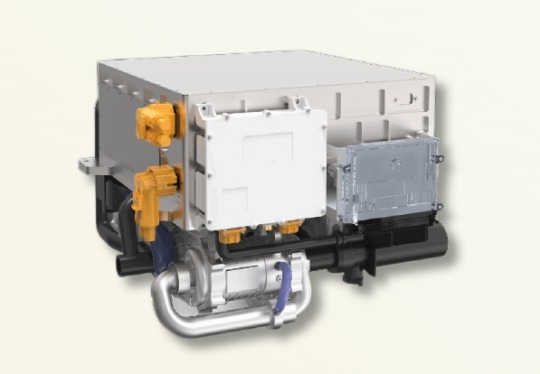Don't wanna be here? Send us removal request.
Text
Fuel Cell Engine: The Future of Clean Energy Transportation

Introduction
The fuel cell engine is revolutionizing the automotive and energy industries by offering a clean, efficient, and sustainable alternative to traditional internal combustion engines. Unlike conventional engines that rely on fossil fuels, fuel cell engines generate electricity through an electrochemical reaction between hydrogen and oxygen, emitting only water vapor as a byproduct. This technology holds immense potential for reducing greenhouse gas emissions and dependence on non-renewable energy sources.
In this article, we will explore how a fuel cell engine works, its advantages over conventional engines, current applications, and the challenges it faces in widespread adoption.
How a Fuel Cell Engine Works
A fuel cell engine operates on the principle of converting chemical energy directly into electrical energy. The core component is the fuel cell stack, which consists of multiple individual fuel cells layered together. Here’s a step-by-step breakdown of the process:
Hydrogen Supply – The engine uses hydrogen gas stored in high-pressure tanks as its primary fuel.
Electrochemical Reaction – Hydrogen molecules are split into protons and electrons at the anode.
Electricity Generation – Electrons travel through an external circuit, creating an electric current that powers the vehicle’s motor.
Oxygen Intake – Oxygen from the air combines with protons and electrons at the cathode, forming water as the only emission.
Unlike batteries, which store energy, fuel cell engines continuously produce electricity as long as hydrogen is supplied, making them ideal for long-range transportation.
Advantages of Fuel Cell Engines
1. Zero Emissions
The most significant benefit of a fuel cell engine is its environmental friendliness. Since the only byproduct is water, it eliminates harmful pollutants like carbon dioxide (CO₂), nitrogen oxides (NOₓ), and particulate matter.
2. High Efficiency
Traditional internal combustion engines waste a significant amount of energy as heat. In contrast, fuel cell engines convert 40-60% of the hydrogen’s energy into usable power, making them far more efficient.
3. Fast Refueling
Unlike battery-electric vehicles that require hours to recharge, hydrogen-powered fuel cell engines can be refueled in just 3-5 minutes, similar to gasoline cars.
4. Long Driving Range
Hydrogen has a high energy density, allowing fuel cell vehicles (FCVs) to achieve ranges of 300-400 miles on a single tank, making them suitable for long-distance travel.
Current Applications of Fuel Cell Engines
1. Automotive Industry
Several automakers, including Toyota, Hyundai, and Honda, have developed fuel cell vehicles like the Toyota Mirai and Hyundai Nexo. These cars demonstrate the practicality of fuel cell engines for personal transportation.
2. Public Transportation
Cities worldwide are adopting hydrogen-powered buses to reduce urban pollution. Countries like Germany, Japan, and China have already deployed fuel cell buses in public transit systems.
3. Heavy-Duty Trucks and Trains
Due to their high energy efficiency and quick refueling, fuel cell engines are being tested in freight trucks and even locomotives, offering a cleaner alternative to diesel engines.
4. Marine and Aviation
Research is underway to integrate fuel cell technology into ships and aircraft, where reducing emissions is a critical challenge.
Challenges Facing Fuel Cell Engines
Despite their advantages, fuel cell engines face several hurdles before they can replace conventional engines on a large scale.
1. Hydrogen Production and Storage
Most hydrogen today is produced from natural gas, which still emits CO₂. Green hydrogen, made using renewable energy, is expensive and not yet widely available. Additionally, storing hydrogen requires high-pressure tanks or cryogenic temperatures, adding complexity.
2. Infrastructure Limitations
The lack of hydrogen refueling stations is a major barrier. Building a widespread hydrogen infrastructure requires significant investment, slowing down adoption.
3. High Costs
Fuel cell engines are currently more expensive than traditional engines due to the use of rare materials like platinum in catalysts. However, advancements in technology are expected to reduce costs over time.
4. Durability and Performance in Extreme Conditions
Cold weather can affect the performance of fuel cell engines, as water produced during the reaction may freeze, disrupting the system. Researchers are working on solutions to improve reliability in all climates.
The Future of Fuel Cell Engines
The fuel cell engine represents a promising pathway toward a sustainable energy future. Governments and private companies are investing heavily in hydrogen infrastructure and research to overcome current limitations.
1. Technological Advancements
Innovations in catalyst materials, membrane durability, and hydrogen storage are expected to make fuel cell engines more efficient and affordable.
2. Policy Support and Incentives
Countries like Japan, South Korea, and the European Union are implementing policies to promote hydrogen fuel cell adoption through subsidies and infrastructure development.
3. Integration with Renewable Energy
By pairing fuel cell engines with wind and solar power, we can create a fully renewable energy ecosystem where excess electricity is used to produce green hydrogen.
Conclusion
The fuel cell engine is a groundbreaking technology that offers a cleaner, more efficient alternative to traditional engines. While challenges remain in hydrogen production, infrastructure, and cost, ongoing advancements and investments are paving the way for broader adoption. As the world shifts toward sustainable energy solutions, fuel cell engines will play a crucial role in decarbonizing transportation and reducing our reliance on fossil fuels.
With continued innovation and support, the fuel cell engine could soon become the standard for zero-emission vehicles, driving us toward a greener future.
1 note
·
View note